
Catalog excerpts

Cardiac Rhythm Therapy Patient's Manual Things to Know About Your Congestive Heart Failure Therapy System
Open the catalog to page 1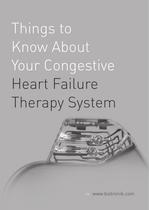
Know About Your Conaestive Heart Failure Therapy System
Open the catalog to page 2
Symptoms of Congestive Heart Failure 7 Medication and Further Therapeutic Measures 12 A New Approach to Treating Congestive Heart 15 Living with a Congestive Heart Failure Therapy 20 Better Quality of Life Thanks to a CHF 21 Therapy System Frequently Asked Questions 31
Open the catalog to page 3
Using electrotherapy to treat congestive heart failure This brochure contains valuable information about BIOTRONIK's new congestive heart failure (CHF] therapy system. If you have further questions, please consult your primary care physician or cardiologist.
Open the catalog to page 4
How the Heart Works The heart is a fist-sized hollow muscle consisting of four chambers. The two atrial chambers (atria) make up the top half of the heart, the two main chambers (ventricles) the bottom half. The heart muscle (called the myocardium) regularly contracts and relaxes in sequence. This motion pumps blood through the body. Blood from the body that is low in oxygen first passes through the right half of the heart and into the lungs, where the blood is then replenished with oxygen. The blood then flows from the lungs to the left half of your heart. From here, the blood is returned...
Open the catalog to page 5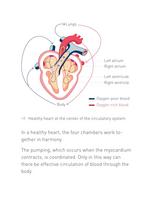
Lungs Left atrium Right atrium Left ventricule Right ventricle Oxygen-poor blood Body Oxygen-rich blood Healthy heart at the center of the circulatory system In a healthy heart, the four chambers work together in harmony. The pumping, which occurs when the myocardium contracts, is coordinated. Only in this way can there be effective circulation of blood through the body.
Open the catalog to page 6
Heart Failure Congestive heart failure is a summarizing techni- cal term for a weakened heart. This condition is one of the most increasingly common cardiac diseases. However, the cause is not always known. CHF develops when the heart muscle is not strong enough to pump enough blood into the body. The body is not sufficiently supplied with oxygen and nutrients. Affected people usually notice the body's insufficient oxygen supply due to a deterio- ration in their ability to cope with physical stress. Fatigue and dizzy spells are common. A backlog of blood is particularly prominent: In many...
Open the catalog to page 7
If water collects in the lungs, patients experience shortness of breath and have coughing attacks, especially when lying down. Asynchronous contraction of the right and left heart chambers reduces the pumping function of the heart in many patients. Heart rhythm disturbances (arrhythmias) may also arise. In this case, the heart beats irregularly because the development or conduction of the heart's own electrical pulses is impaired. The heart no longer beats in a coordinated fashion, so the pumping function becomes even more reduced, which results in the body not being supplied with enough...
Open the catalog to page 8
Pathologically enlarged heart with CHF (cf. fig. p. 7) 8|9
Open the catalog to page 9
Monika S., born in 1950, early retiree from Hamburg
Open the catalog to page 10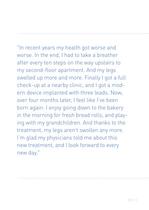
"In recent years my health got worse and worse. In the end, I had to take a breather after every ten steps on the way upstairs to my second-floor apartment. And my legs swelled up more and more. Finally I got a full check-up at a nearby clinic, and I got a modern device implanted with three leads. Now, over four months later, I feel like I’ve been born again: I enjoy going down to the bakery in the morning for fresh bread rolls, and playing with my grandchildren. And thanks to the treatment, my legs aren’t swollen any more. I’m glad my physicians told me about this new treatment, and I look...
Open the catalog to page 11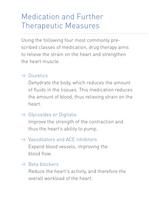
Therapeutic Measures Using the following four most commonly pre- scribed classes of medication, drug therapy aims to relieve the strain on the heart and strengthen Dehydrate the body, which reduces the amount of fluids in the tissues. This medication reduces the amount of blood, thus relieving strain on the mprove the strength of the contraction and thus the heart's ability to pump. Expand blood vessels, improving the blood flow. Reduce the heart's activity, and therefore the overall workload of the heart.
Open the catalog to page 12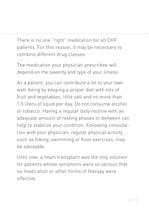
There is no one "right" medication for all CHF patients. For this reason, it may be necessary to combine different drug classes. The medication your physician prescribes will depend on the severity and type of your illness. As a patient, you can contribute a lot to your own well-being by keeping a proper diet with lots of fruit and vegetables, little salt and no more than 1.5 liters of liquid per day. Do not consume alcohol or tobacco. Having a regular daily routine with an adequate amount of resting phases in-between can help to stabilize your condition. Following consultation with your...
Open the catalog to page 13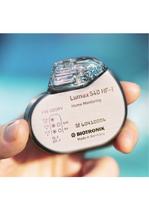
Home Monitoring
Open the catalog to page 14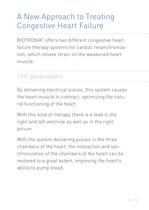
A New Approach to Treating Congestive Heart Failure BIOTRONIK offers two different congestive heart failure therapy systems for cardiac resynchronization, which relieve strain on the weakened heart muscle. ® CHF pacemakers By delivering electrical pulses, this system causes the heart muscle to contract, optimizing the natural functioning of the heart. With this kind of therapy, there is a lead in the right and left ventricle as well as in the right atrium. With the system delivering pulses in the three chambers of the heart, the interaction and synchronization of the chambers of the heart...
Open the catalog to page 15
The CHF pacemaker primarily consists of an electronic circuit and a battery. The device is usually implanted beneath the skin, under the left collarbone. This is similar to a standard pacemaker implantation. Three thin insulated wires, the leads, are also part of the pacemaker system. These wires connect the CHF pacemaker to the heart.
Open the catalog to page 16
The congestive heart failure therapy system is connected to the heart via three leads The leads conduct the electrical pulses to the heart, and also transmit information about the heart’s activity back to the CHF pacemaker, allowing it to react appropriately to every situation. 16 | 17
Open the catalog to page 17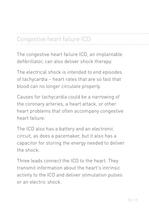
Congestive heart failure ICD The congestive heart failure ICD, an implantable defibrillator, can also deliver shock therapy. The electrical shock is intended to end episodes of tachycardia – heart rates that are so fast that blood can no longer circulate properly. Causes for tachycardia could be a narrowing of the coronary arteries, a heart attack, or other heart problems that often accompany congestive heart failure. The ICD also has a battery and an electronic circuit, as does a pacemaker, but it also has a capacitor for storing the energy needed to deliver the shock. Three leads connect...
Open the catalog to page 19All Biotronik catalogs and technical brochures
-
Orsiro
6 Pages
-
Pantera Pro
5 Pages
-
3Flow
2 Pages
-
PRO-Kinetic Energy
5 Pages
-
Magmaris
6 Pages
-
Passeo-35 HP
4 Pages
-
Pulsar-18
6 Pages
-
Galeo Pro
2 Pages
-
Fortress
3 Pages
-
Passeo-35
3 Pages
-
Passeo-18
3 Pages
-
Passeo-14
3 Pages
-
Conditions Overview
6 Pages
-
Closed Loop Stimulation
50 Pages
-
PK Papyrus
4 Pages
-
Astron
4 Pages
-
Pantera LEO
5 Pages
-
Lumax 740
1 Pages
-
BioMonitor
8 Pages
-
Protego
6 Pages
-
Idova 7
8 Pages
-
PRO-Kinetic
12 Pages
-
Magnum
2 Pages
-
Galeo
8 Pages
-
Streamer
2 Pages
-
AngioSculpt PTCA
2 Pages
-
BIOTRONIK Home Monitoring®
44 Pages
-
New Lease of Life
94 Pages
-
Pacemaker
48 Pages
Archived catalogs
-
Passeo-35 HP craking
3 Pages

































